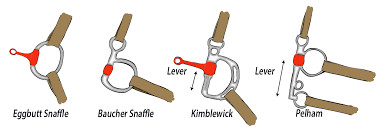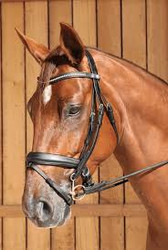Setting the Record Straight — The Baucher Bit Explained (Again.)
Posted by Charmae Bell on Oct 08, 2025
Let’s talk honestly about the Baucher (again - with references.)
Few bits cause as much confusion as the Baucher (or Hanging Cheek Snaffle). I often hear riders and professionals say, “It adds poll pressure and uses leverage,” or “It’s like a mini-gag,” and honestly, those comments are everywhere online.
And I cant believe its still a topic of debate in 2025!
But when you actually look at the geometry and the available research, that’s not what’s happening at all. The Baucher’s reputation for leverage is mostly myth — and it deserves a fair explanation.
How it really works
A true leverage bit has two arms (an upper purchase and a lower shank) with a pivot point between them (the mouthpiece). The rein is attached below the mouthpiece, so every pull multiplies force through the lever.
The Baucher doesn’t have that. The rein ring sits level with the mouthpiece — there’s no lower shank, no pivot, and no multiplier. The rein slips up to the highest point of the ring under contact, making it a direct action snaffle.
What makes it unique is the fixed cheek with upper purchase: it holds the bit a little more still in the mouth and in a neutral position. That stability can be brilliant for sensitive horses who hate the movement of a loose ring, and those that need poll releif. It gives them a consistent, quiet contact instead of constant motion.
So, if we take away the internet theories and just look at the mechanics, the Baucher is a stability tool, not a leverage tool.

What the research actually shows
This isn’t just opinion — it’s been measured and peer reviewed.
The landmark sensor study by Benoist & Cross (2016), Assessment of Poll Pressure Induced by a Baucher / Hanging Cheek Snaffle, looked at how rein tension affects the cheekpieces.
They discovered something fascinating:
-
At normal rein contact levels (0–3 kg, or roughly 0–30 N), the cheekpiece tension actually dropped below the bit’s resting “pre-tension.”
-
In plain English, that means the Baucher was relieving pressure at the poll, not increasing it - therefore not a lever or leverage bit.
-
Only when rein force became much higher did the cheekpieces begin to engage again — and even then, the increase was small.
The researchers proposed that as the reins are taken up, the bit slightly rotates forward and slides fractionally along the tongue, which slackens the cheekpieces.
That finding has been backed up by later summaries and mechanical analyses from Neue Schule’s “Poll Pressure Guide” and coverage in Horse & Hound and HQ Magazine, which all reported the same outcome: at typical rein tension, the Baucher reduces, not adds, poll pressure.
It’s one of the few times we have actual scientific data — not just anecdotes — on what’s happening inside the mouth and on the bridle.
What that means in practice
If it’s fitted correctly and the rider’s hands are kind, the Baucher can:
-
Offer a more stable, consistent feel in the mouth
-
Slightly relieve poll tension under light contact
-
Help steady contact for horses that dislike bit movement
But it’s not magic — and it’s not a substitute for good hands or good fit.
If it’s fitted too wide, uneven, or used with the wong mouthpiece for the horse, it can still cause discomfort. And if the rider’s hand is too strong or unsteady, no bit design on earth will be comfortable or suitable.
Fitting tips we use at Bit Bank Australia
-
Choose a width that sits close to the corners of the mouth — not tight so its squashing the lips inwards, no space between lip and cheek.
-
Check both cheekpieces are even and the bridle isn’t lopsided or crooked.
-
Under steady, working contact, the lips should stay symmetrical with no excessive stretch or drag.
-
Watch for signs like fussing with the mouth, tilting thehead, or one-sided/uneven contact, reefing, behind the bit — those are valuable signs of feedback the bit isnt right.
The takeaway
The Baucher isn’t a curb in disguise. Its not a leverage bit. Its not severe. Its not a gag.
It’s a quiet, stable bit that — when fitted correctly — can actually lighten the load at the poll and offer horses a more peaceful, quiet feel in the mouth.
So next time you hear someone confidently say, “Oh, that adds poll pressure,” you’ll know that’s not what the data says.
At Bit Bank Australia, we care about evidence, not hype or opinion — because the horse always deserves the truth. ??
References
-
Benoist, C. C., & Cross, G. H. (2016). Assessment of Poll Pressure Induced by a Baucher / Hanging Cheek Snaffle. Independent sensor study commissioned by Neue Schule.
-
Neue Schule. Benefits of the Baucher and Poll Pressure Guide. Available via nsbits.com.
-
Horse & Hound (2016). Bitting Debate Resolved “Once and for All”. Coverage of the Baucher poll pressure study.
-
HQ Magazine. The Hanging Cheek Snaffle Debate – Solved. Industry summary of Benoist & Cross results.
-
Picadera.de. Myth: The Baucher and Leverage. German retailer summary explaining why the Baucher lacks lever mechanics.
-
Hilary M. Clayton (2016). Equine Biomechanics and Bridle Pressure Notes. Michigan State University lecture materials.
 AUD
AUD  New Zealand Dollars
New Zealand Dollars
 US Dollar
US Dollar

